
 |

Andre Agassi - The Finest Two Fisted Backhand in
the Game
Jim
McLennan, Senior Editor, TennisONE
To see the animation of Agassi backhand,
click here.
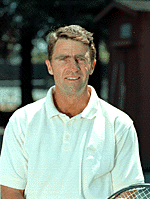 Andre is resurgent,
playing like the Andre of old, so lean and keen perhaps even
better than before, time will tell. Asked how he would evaluate
a successful 1998 tournament campaign, he answered, "Yes,
I think I can win a Slam this year, and my best shot is in the
Big Apple!" Andre is resurgent,
playing like the Andre of old, so lean and keen perhaps even
better than before, time will tell. Asked how he would evaluate
a successful 1998 tournament campaign, he answered, "Yes,
I think I can win a Slam this year, and my best shot is in the
Big Apple!"
Dominating play with an enormous return of serve, great court
movement, and an improved serve, the one area of his game that
receives little attention is his two handed backhand, even though
his father has said he believes it is Andre's best stroke, and
from my position on the sidelines I agree.
Studying Andre's two hander, the overwhelming feature
is simplicity. But, as in all things, simple is not necessarily
easy, but if understood, well worth copying. An aside on simplicity.
Mickey Mantle's father is said to have been a genius for encouraging
(or making) his son switch hit as a 10 year old boy. To Mickey's
father, the advantage of switch hitting was (and still is) obvious,
but it was to Dad's credit that Mickey adopted this technique
as a young boy. Obvious, simple, where is the genius here? Perhaps
in acting on such a simple premise. Well the same applies to
the square stance on the Agassi two handed backhand. It produces
great advantages yet few professionals or aspiring juniors really
hit from this position.
The key elements you see in the accompanying photos
are setting up on the back foot in line with the ball, turning
both the hips and shoulders against the ball, and positioning
a recovery step immediately after the hit.
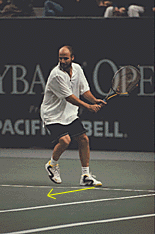 1.
Positioning for the hit: The key to this backhand is placing
the back foot. in line with the ball, so that the front
foot moves precisely into the ball rather than across. Phil Cello
calls this the "educated foot". All the old tennis
books advise stepping into (not across) the ball and Andre
follows this to a tee. 1.
Positioning for the hit: The key to this backhand is placing
the back foot. in line with the ball, so that the front
foot moves precisely into the ball rather than across. Phil Cello
calls this the "educated foot". All the old tennis
books advise stepping into (not across) the ball and Andre
follows this to a tee.
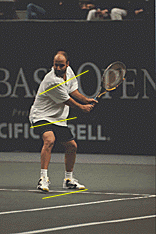
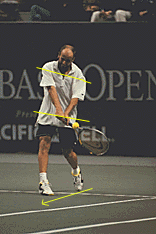
2.
Hips and Shoulders: Having positioned perfectly, notice how
Andre's hips and shoulders both turn into the ball. The combined
hip and shoulder turn increases power, improves balance, and
makes for a simple hit. Notice also how the racquet moves in
line with his arms and below the ball, so he quickly and forcefully
pulls the racquet up and into the hit.
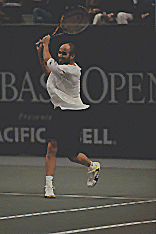
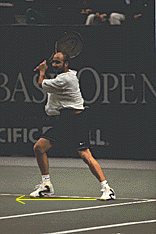 3.
Recovery Step: "Recover, recover, recover !"
I can still hear my original coaches voice on this one. Andre
does just that, his body weight is carried forward and back toward
the center of the baseline as he continues to rotate after the
hit. With Agassi's incredible ball speed, he has precious little
recovery time, and he makes the most of it with this subtle yet
effective recovery movement. 3.
Recovery Step: "Recover, recover, recover !"
I can still hear my original coaches voice on this one. Andre
does just that, his body weight is carried forward and back toward
the center of the baseline as he continues to rotate after the
hit. With Agassi's incredible ball speed, he has precious little
recovery time, and he makes the most of it with this subtle yet
effective recovery movement.
Contrast the above with the closed stance where a player steps
across rather than into the ball. In this model the player does
not get in position on the back foot so the front foot moves
across to the ball. When striking the ball from such a
closed stance the hips do not turn as far into the hit so power
is lost, balance is more difficult, and the footwork after the
hit actually carries the player away from the center of the court
rather than back toward the center.
A final note: , I have studied Andre's game for many years,
and believe if he didn't run around his backhand
he could approach the net on more occasions and improve his winning
opportunities. Certainly Jimmy Connors enjoyed enormous
success with his similarly punishing groundstrokes and a forcing
game from the midcourt and net. The biggest contrast I see between
his offensive game and Andre's is the approaching midcourt groundstroke.
When Andre runs around the backhand (which Connors never
did), he gives up so much court (as do Courier and Chang) that
he cannot truly move forward after the hit. Sampras studied
Laver and developed an attacking topspin all court game. Andre
should get out some old Connors footage, watch him constantly
moving forward, and hopefully add another Slam title (or two)
to his collection.
Send email to the author
We encourage you to email your comments (pro, con, appreciative,
whatever) directly to the author. To send email to Jim McLennan,
click here.
Visit the TennisONE Library
to see more of Jim McLennan's lessons. |